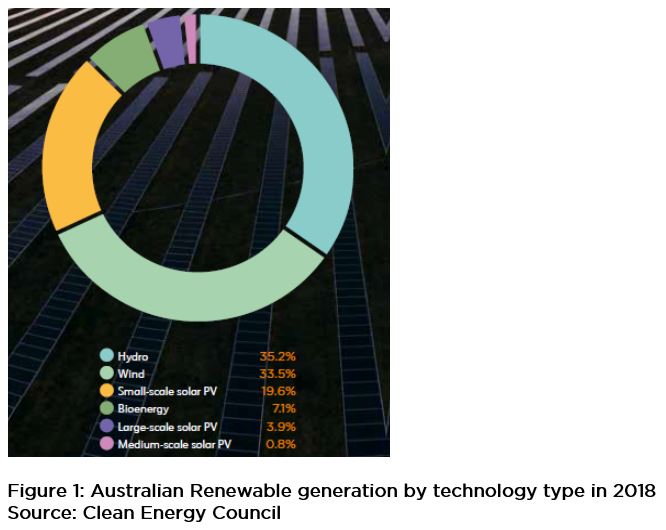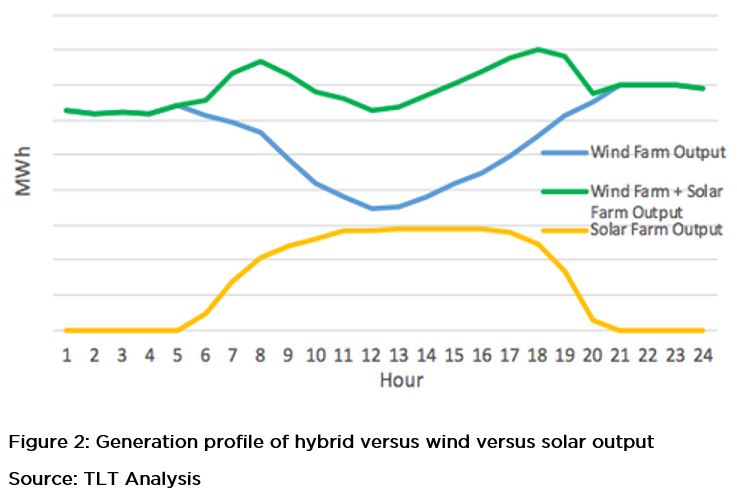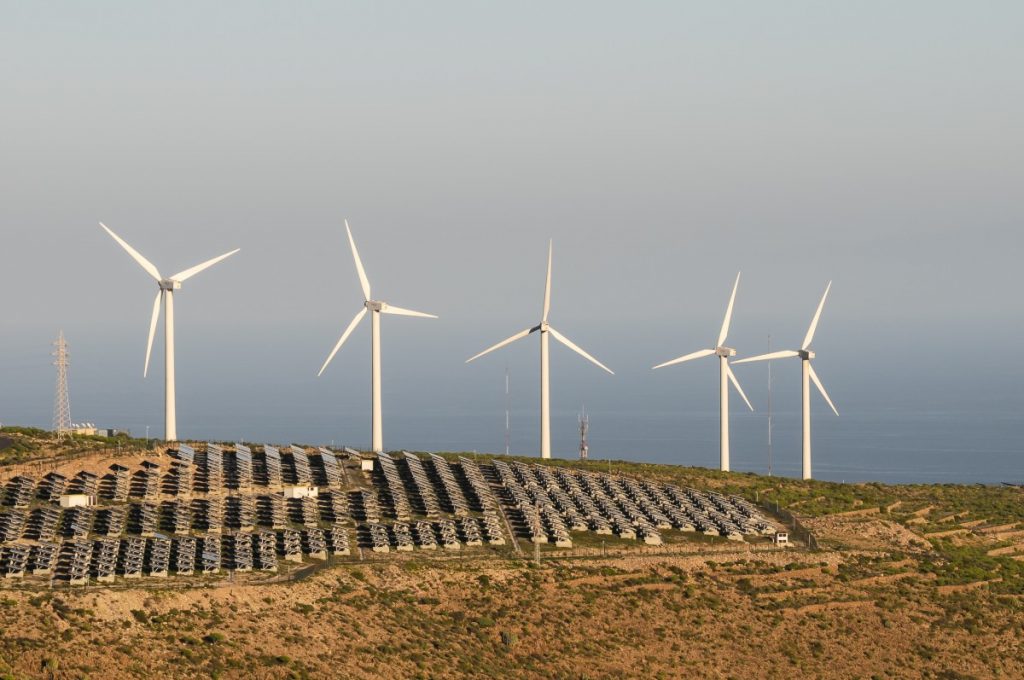Should solar and wind pair up to power our future?
Isometric 3d vector illustration of windmill and solar panels. Alternative energy. Icon for web. Isolated on white background.
We’ve all heard about how solar photovoltaics (PV) is breaking records in Australia, on our roofs and in our paddocks. Here’s a snapshot of what happened in the Australian solar world of 2018[1]:
- Small-scale solar (up to 100 kW) was responsible for 19.6 per cent of Australia’s clean energy generation;
- Installations for medium-scale solar systems (from 100 kW to 5 MW) grew by 80 per cent; and
- Large-scale solar (larger than 5 MW) officially announced its arrival by adding 1,442 MW of new capacity.
Australia also generates renewable electricity via wind, which is usually at large-scale. In 2018, Australia’s wind farms produced 33.5 per cent of the country’s renewable energy.
Figure 1 provides a breakdown of renewable power generation from wind and solar in 2018.

Solar PV generation is expected to continue to grow rapidly, as is wind – and while solar only works during sunny days, there tends to be plenty of wind when there’s no sun. A key issue with wind however, is it blows intermittently and is seasonally variable.
So, what if we partner solar PV and wind generation to form a hybrid system? Are there any benefits? Let’s put a lens on the hybrid system.
What is a hybrid?
Consider a hybrid renewable energy system as a recipe, where wind turbines and solar PV are our main ingredients. To spice up our hybrid recipe, we can add a storage system and also retrofit to an existing diesel-generator system.
Solar and wind energy is abundant in Australia, but both are unpredictable and sometimes unable to meet peak demand due to changes in weather and climate patterns.
In Australia, winter and spring bring strongest winds and summer and autumn strongest sunshine. Wind speed increases from afternoons to evenings and mornings and when it drops off, the sun takes over. So it seems solar and wind could fill each other’s energy gaps[2].
The advantages of forming a solar PV-wind hybrid partnership are that system reliability and grid stability get enhanced. Battery storage size gets reduced because there is less reliance on one method of power generation. Also, hybrid systems yield greater economic and environmental returns than wind and solar stand-alone systems by themselves.
Another positive is having wind and solar farms co-located. This enables use of existing infrastructure, such as network connections, roads and communications systems. This reduces the cost of grid connections, site development and approvals. However, hybrid systems can have complexities of design, optimisation and operation control[3].
Combining solar PV and wind turbines at the same location can yield up to twice the amount of electricity as having either system working alone to meet demands.
This is illustrated below at Figure 2. By combining wind energy (with an evening peak) and solar energy (with a daytime peak), the two farms that make up South Australia’s Snowtown wind-solar complex can combine to better match daily demand[4].


Hybrid Internationally
Solar-wind hybrids have been embraced internationally:
- India has a national wind-solar hybrid policy that aims to provide a framework for promoting large grid connected wind-solar PV hybrid systems.
- Thailand has taken hybrid coolness to another level by combining hydro power from a dam with solar panels floating on its reservoir to give a constant stream of energy. Thailand intends to follow this up with 15 more projects at dams around the country, pending technical success[5].
- Sweden is taking the lead on the world’s first self-sufficient energy housing complex run entirely on solar PV and stored hydrogen[6].
Is there a hybrid future for Australia?
- Australia’s first solar PV-wind hybrid (Gullen Solar Farm) was launched in NSW in 2018. It is a 10 MW solar farm surrounded by a 73 turbine wind farm which complement each other with the wind farm generating more during winter and solar farm generating more in summer. Building the solar farm next to the existing wind project reduced the project cost by 20 per cent.
- The Walcha Energy Project in New England Tableland has been recognised for its renewable energy potential and included in the Australian Energy Market Operator’s Integrated System Plan. It combines solar and wind energy generation with pumped storage hydro. With an electricity generation potential of 15 per cent of NSW’s electricity demand, it offers more than the output of Liddell Power Station[7].
- Sapphire renewable energy hub in northern NSW is adding large-scale solar and battery storage to its existing wind farm in 2019.
- Solar PV-wind can also be paired with diesel, where a diesel generator is used as a backup solution. This system has lower maintenance requirements than a diesel power generation system. Western Australia’s Rottnest Island and South Australia’s Coober Pedy are successful examples of solar-wind-diesel hybrid systems. Rottnest Island has stepped up a notch by integrating solar and wind generation resources with the island’s desalination plant and water storage facilities. This means surplus renewable energy creates clean drinking water[8].
Australia is gaining momentum in the solar-wind hybrid space as we aim to take advantage of the best of both worlds. The good news is solar and wind are excellent complements to one other. We have started with a hybrid recipe of the right combination of wind and solar. Now the challenge is to spice it up with a healthy serve of hydrogen storage and EV charging.
[1] Clean Energy Australia Report 2019 https://assets.cleanenergycouncil.org.au/documents/resources/reports/clean-energy-australia/clean-energy-australia-report-2019.pdf
[2] Wind resource assessment in Australia – a planners guide http://www.cmar.csiro.au/e-print/open/coppin_2003a.pdf
[3] Comparative study of stand-alone and hybrid solar energy systems suitable for off-grid rural electrification: A review
https://www.sciencedirect.com/science/article/pii/S1364032113004346
[4] Snowtown North Solar Farm
https://www.tiltrenewables.com/assets-and-projects/Snowtown-North-Solar-Energy-Farm/
[5] This floating solar farm is a dam clever climate change weapon
https://www.wired.co.uk/article/sirindhorn-dam-thailand-solar-panels
[6] Swedish Housing Powered 100 Percent by Sun and Hydrogen
https://fuelcellsworks.com/news/swedish-housing-powered-100-percent-by-sun-and-hydrogen/
[7] Walcha Energy Project


